Early this morning, Idalia was classified as a hurricane. This is now the 3rd of the 2023 Atlantic hurricane season. On average, the 3rd Atlantic hurricane forms on September 7th. According to the season forecasts tracked by the Barcelona Supercomputing Center, it should be noted that the average forecast is for 8 hurricanes to develop this season. Franklin, which is a monster of a hurricane West of Bermuda with a pressure of 935 mb and winds of 140 mph, and Idalia are now hurricanes that will go right along with the expected climatological activity as we approach the September 10th peak of the hurricane season.
Since last week, these BMS Tropical Updates have been warning clients and prospects of the formation of Idalia and the potential impacts given the overall environment, which essentially has to do with high Ocean Heat Content values and upper atmospheric dynamics that will promote storm strengthening and likely a period of rapid intensification. The only variable that will limit intensity is time before landfall, faster forward motion, and the potential for dry air to be entrained into Idalia as it grows into size. However, very little has changed with the overall ideas laid out over the last few days, as Idalia still looks to be a life-threatening storm with some mild impacts on the insurance industry. Some models bring it ashore as a Category 4. Others are Category 3, which is more likely at this time. As also highlighted, the Florida Gulf Coast's Big Bend region is extremely surge-vulnerable with likely up to 8-12 feet of inundation.
There is a saying that weather memory is generational, and that is indeed the case for anyone who lives along the Big Bend region of the Florida Gulf Coast. Although the area is no stranger to weak hurricanes and tropical storms, with Idalia expected landfall as a major hurricane, it would be just the second Category 3 or higher to do so in the last 172 years. This results in some of the longest return periods for a major hurricane outside the Northeast coastline. With areas of the Big Bend of Florida having a return period of a major hurricane every 30 to 45 years.
Unlike Hurricane Ian's forecast last September, the general forecast for Idalia to have a landfall within the Apalachee Bay, Big Bend region of the Florida Gulf Coast has not changed much since Friday. As always, adjustments in the forecast track are likely to occur over the next 36 hours, but do not bank on a sudden forecast change, Idalia.
As mentioned, there is really no historical precedence, with the only other major hurricane in the section of the coast struck in 1896. In today's dollars, this event would have an insurance loss range of $8 to $12B, however, there is still uncertainty with this number as many communities in this area have never experienced such strong winds before. These communities will be tested by all four hurricane hazards—surge, wind, rain, and tornadoes—with no modern reference point for such an event.
Let us go one-by-one through each of those hazards to get a complete picture of Idalia's threat to the insurance industry.
Storm Surge
Time and time again, we have seen that water is the true killer in a hurricane, and no hazard is more deadly or destructive than a storm surge. Ian should be in recent memory, and it revealed that the most damaging storm surge is not where the hurricane makes landfall, but it can be far removed down the storm's right side. There are still some questions about the overall size of Idalia's wind field as it develops into a major hurricane. Ian will also be moving with a relatively fast forward speed of 18 to 20 mph, which could limit some of the storm surge impacts more than if Ian was a slower-moving storm. With this uncertainty, the wind field of Idalia’s eastern half will push a wall of water north onto the shallow continental shelf that last-minute changes in maximum winds or track cannot alter. An ill-timed full moon on Wednesday will further enhance tides and flood potential. Minor coastal flooding could occur in the Tampa Bay areas. In fact, minor flooding occurred in Coffee Pot Bayou in northeast St. Pete along Tampa Bay yesterday.
The best resource to understand storm surge Inundation impacts is from the National Hurricane Center (NHC). Below is the current forecast based on Advisory 11.
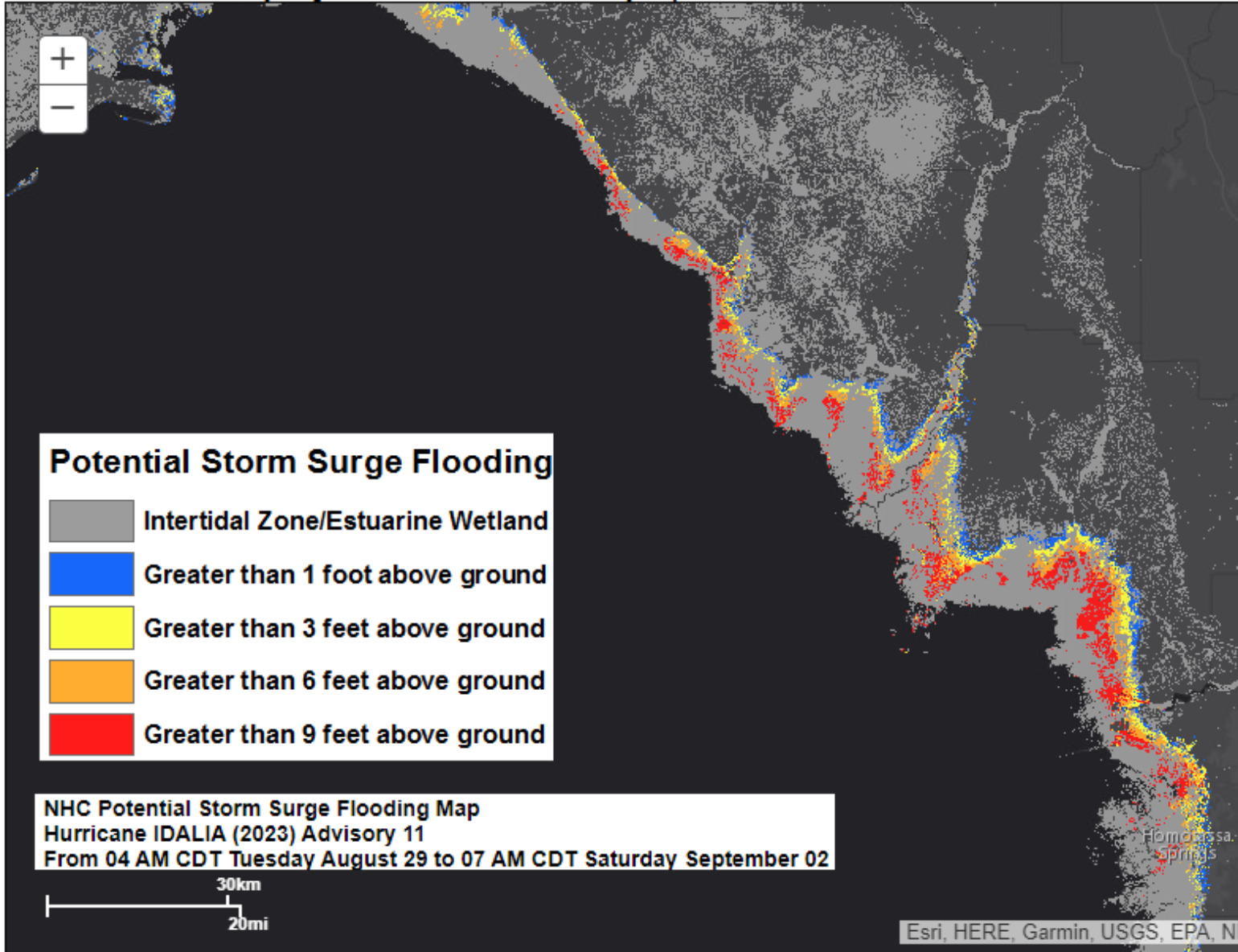
Wind
Hurricane forecast winds and the gust that caused most of the damage will surely be capable of knocking out power. Furthermore, damaging trees will occur over a wide region extending from the Central Panhandle starting late Tuesday. Idalia’s truly destructive winds will likely occur over a much more limited area near the center of circulation on Wednesday.
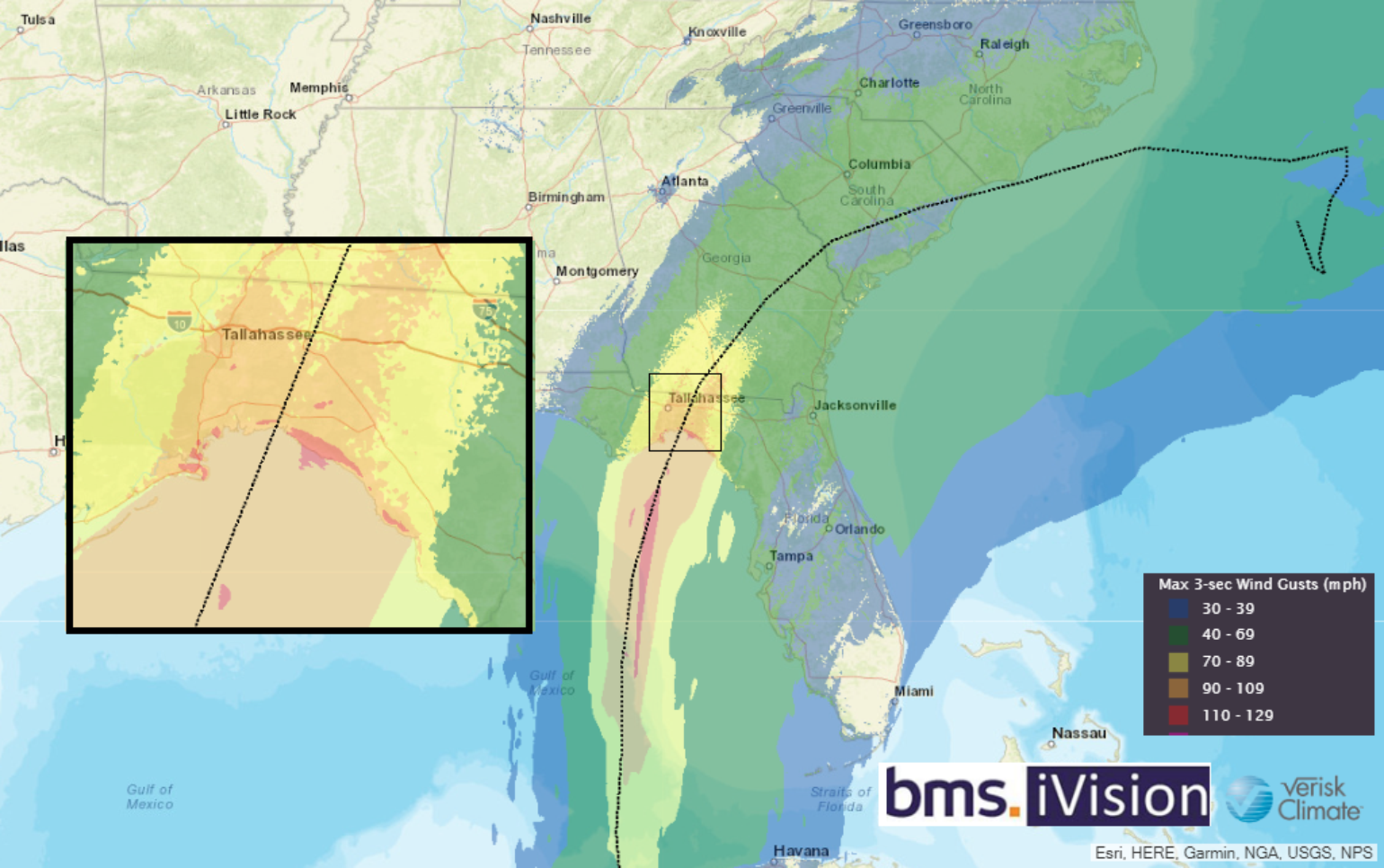
The detailed wind gust swath from BMS iVision above shows just one possible solution. Of course, the wind speed and its destructive capabilities will depend on the building components. As mentioned, a major hurricane with such severe wind speeds has not tested this part of Florida's building stock. We also know the building codes are less strict in the northern part of the state compared to those in the southern region. Although the landfall areas are generally less populated, the areas also rank as one of the lowest on the FEMA National Risk Index for community resilience, with a few counties having relatively high social vulnerability and low community resilience.
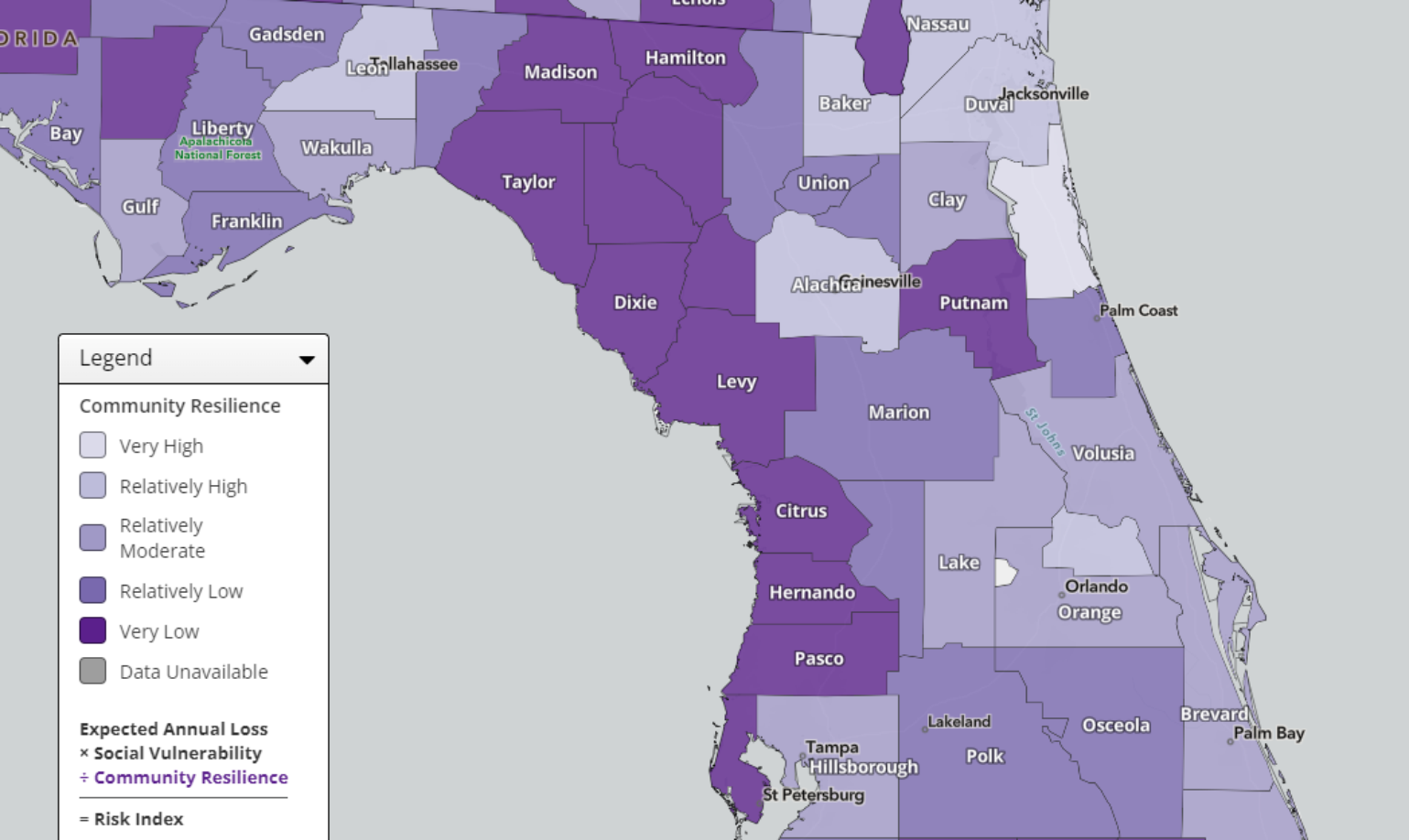
The most significant uncertainty with the wind is if the forecast track continues to shift slightly west. There is a chance higher winds impact the more populated area around Tallahassee, FL. Still, at this point, the weaker side of the storm (left) would affect this area, but the city could still encounter damaging winds resulting in high tree fall and increased destruction to structures. The good news is that the areas have been dry, which means the dry soil will support tree root systems compared to very wet soil. Tallahassee impacts are likely the wildcards in the overall insurance industry loss projection at this time.
Rainfall
Yesterday, we highlighted the potential for some areas of major flooding in the Southeast states. With Idalia likely accelerating by landfall to a forward speed of a brisk 15-20 mph, heavy rainfall will be a secondary impact of the storm. As Idalia will produce the heaviest and through mid-day Wednesday in the eastern Panhandle, northeast Florida, and west-central Florida, where storm totals of 4-8” are likely and localized flash flooding is possible. Overall, the rainfall forecast has decreased since yesterday for the Southeast due to the faster forward motion of Idalia as it exits the southeast coastline.
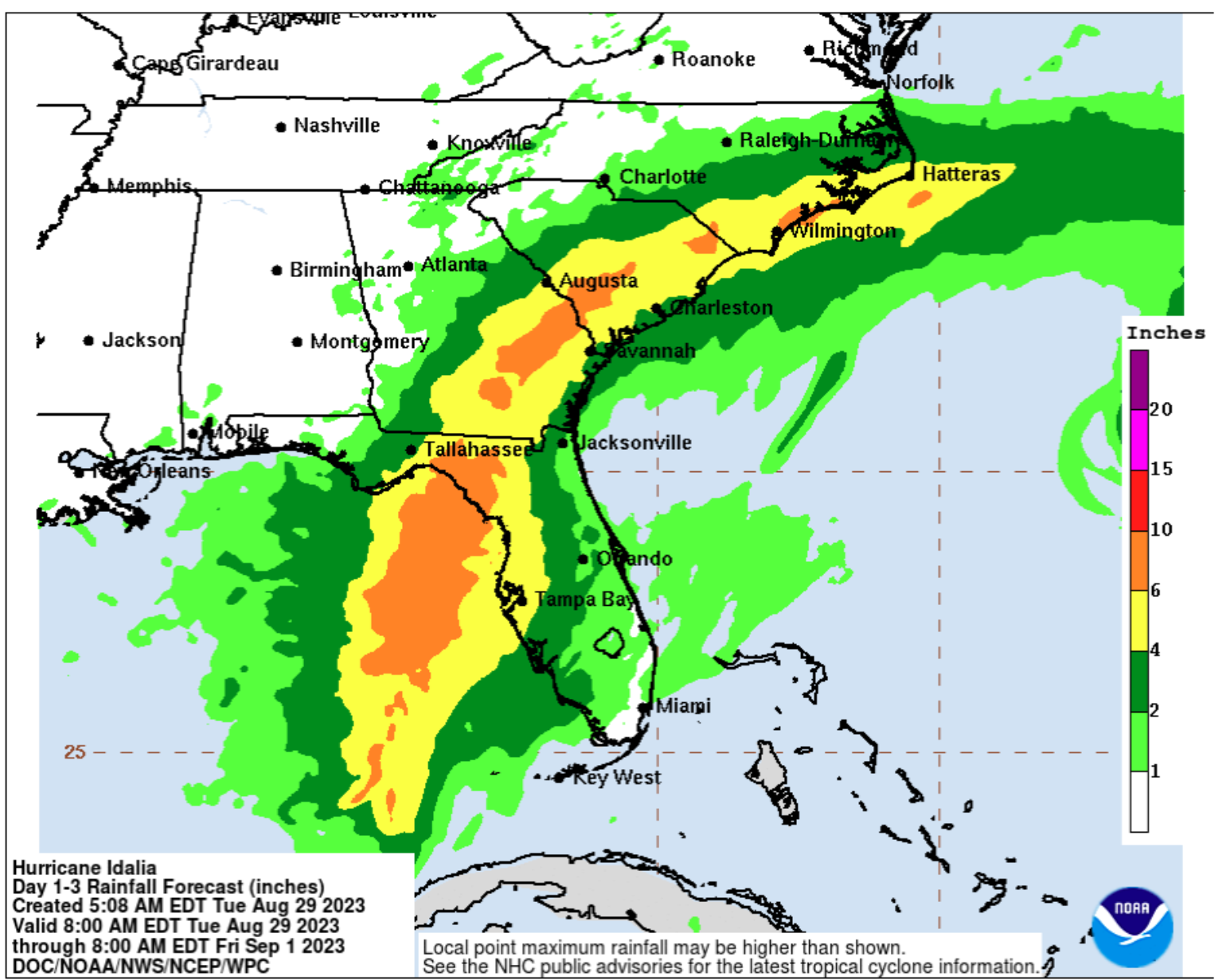
Tornadoes
Tornadic activity is expected in landfalling hurricanes, mostly in bands north and east of the circulation center. Occasional tornadic cells within outer bands are most likely on Tuesday in west-central Florida, with some chance of short-lived tornadoes across the rest of the peninsula. Tornado risks will spread north and focus on northeast Florida on Wednesday.
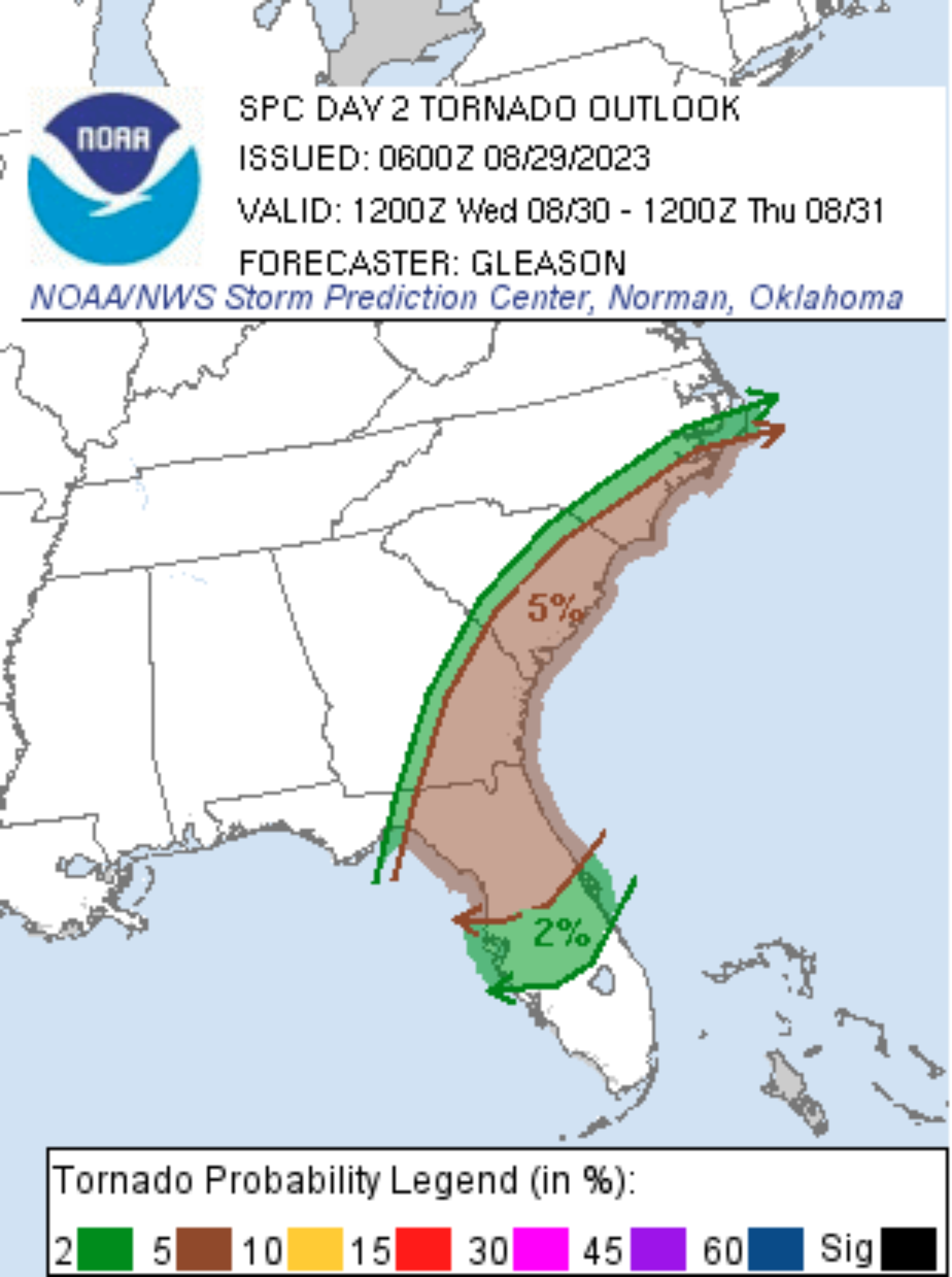
Insurance Industry Loss
The Tampa Bay scenario of major hurricanes is mainly off the table. Overall loss ranges will likely be much lower today from the various catastrophe modeling companies. With the general lower population density, as shown in yesterday's tropical update in the landfall region, the overall industry loss will be lower than if the storm had tracked up the Interstate 4 corridor. With the lower exposure concentration and the likelihood that overall attachment points have moved much higher on insurance companies' catastrophe risk programs, this will likely be a retained event for some insurance companies with limited reinsurance impacts. With little historical analogs, a lot of weight will be put on the catastrophe model to understand losses. In looking at some of the similar events within their catalogs, the loss should end up in the range of $3 to $6B, but this all depends on how far the wind field impacts the Tallahassee area. Right now, it looks like the strongest winds will mostly move over rural areas and large parts of central Florida that swamp, such as the Mallory Swamp and the Osceola Wildlife Managment, up into Georgia Okefenokee Swamp area, all with a fairly low population density providing lower industry losses.
Idalia might not just go away
After Idalia makes landfall in Florida, it will turn east and reemerge into the southwest Atlantic. Some guidance suggests that a strong surface high will build north of the storm. A recurve back southward is not impossible, model spread significantly increases late in the week.
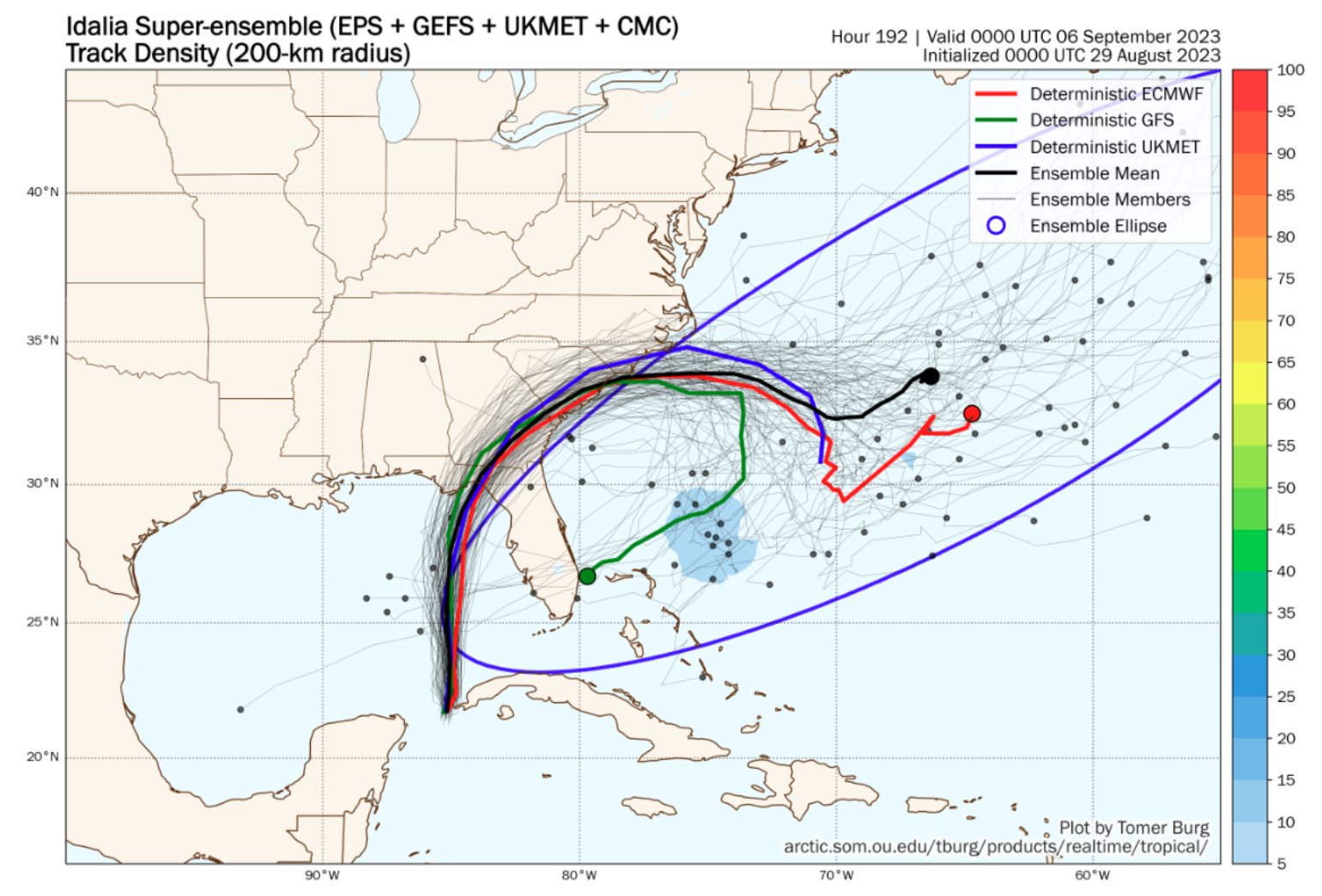
Bottom Line:
• Very little has changed overnight. Idalia still looks to be a life-threatening storm.
• Some models bring it ashore as a Category 4. Others a Category 3. Devastating impact possible regardless.
• This is an extremely surge-vulnerable area. Up to 8-12 feet of inundation likely.
• Inland Flooding and rainfall threat has decreased for the Southeast.
• Insurance industry losses will depend on the Tallahassee Area's overall impacts.
